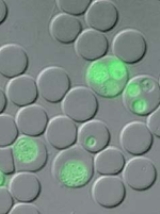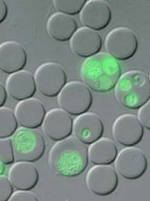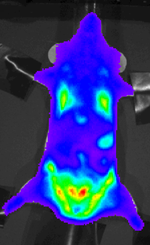
Plasmodium berghei
Encyclopedia
Plasmodium berghei is a unicellular parasite (protozoan) and it infects mammals other than humans.
P. berghei is one of the four Plasmodium
species that have been described in African murine
rodent
s.
These are not of direct practical concern to man or his domestic animals. The interest of these parasites is that they are practical model organisms in the laboratory for the experimental study of human malaria
.
.
, where its natural cyclic hosts are the thicket rat (Grammomys surdaster) and the mosquito
(Anopheles dureni).
or a vaccine
against malaria.
In the laboratory the natural hosts have been replaced by a number of commercially available laboratory mouse strains, and the mosquito Anopheles stephensi
, which is comparatively easily reared and maintained under defined laboratory conditions
Rodent
parasites are recognised as valuable model organisms for the investigation of human malaria
because they are similar in most essential aspects of morphology, physiology and life cycle and the manipulation of the complete lifecycle of these parasites, including mosquito infections, is simple and safe.
Like all malaria parasites of mammals, including the four human malaria
parasites, P. berghei is transmitted by Anopheles
mosquitoes and it infects the liver after being injected into the bloodstream by a bite of an infected female mosquito. After a short period (a few days) of development and multiplication, these parasites leave the liver and invade erythrocytes (red blood cells). The multiplication of the parasite in the blood causes the pathology such as anaemia and damage of essential organs of the host such as lungs, liver, spleen. P. berghei infections may also affect the brain and can be the cause of cerebral complications in laboratory mice. These symptoms are to a certain degree comparable to symptoms of cerebral malaria in patients infected with the human malaria parasite Plasmodium falciparum
.
The complete genome
of P. berghei has been sequenced and it shows a high similarity, both in structure and gene
content, with the genome of the human malaria parasite Plasmodium falciparum
.
 P. berghei can be genetically manipulated in the laboratory using standard genetic engineering
P. berghei can be genetically manipulated in the laboratory using standard genetic engineering
technologies. Consequently this parasite is often used for the analysis of the function of malaria genes using the technology of genetic modification.
A number of genetically modified P. berghei lines have been generated which express fluorescent reporter proteins such as Green Fluorescent Protein
(GFP) or bioluminescent reporters such as Luciferase
. These transgenic parasites are important tools to study and visualize the parasites in the living host.
 The use of this model malaria parasite has provided biologists and medical researchers with more insight into:
The use of this model malaria parasite has provided biologists and medical researchers with more insight into:
- The interactions of malaria parasites with the immune system
.
- The process of infection of the liver by malaria parasites.
- The cause of severe pathology, such as cerebral complications in malaria patients.
- The infection of the mosquito and transmission of the parasite by the mosquito.
Moreover, P. berghei is used in research programs for development and screening of anti-malarial drugs and for the development of an effective vaccine against malaria.
Information about the genome and genes of P. berghei:
P. berghei is one of the four Plasmodium
Plasmodium
Plasmodium is a genus of parasitic protists. Infection by these organisms is known as malaria. The genus Plasmodium was described in 1885 by Ettore Marchiafava and Angelo Celli. Currently over 200 species of this genus are recognized and new species continue to be described.Of the over 200 known...
species that have been described in African murine
Murinae
The Old World rats and mice, part of the subfamily Murinae in the family Muridae, comprise at least 519 species. This subfamily is larger than all mammal families except the Cricetidae and Muridae, and is larger than all mammal orders except the bats and the remainder of the...
rodent
Rodent
Rodentia is an order of mammals also known as rodents, characterised by two continuously growing incisors in the upper and lower jaws which must be kept short by gnawing....
s.
These are not of direct practical concern to man or his domestic animals. The interest of these parasites is that they are practical model organisms in the laboratory for the experimental study of human malaria
Malaria
Malaria is a mosquito-borne infectious disease of humans and other animals caused by eukaryotic protists of the genus Plasmodium. The disease results from the multiplication of Plasmodium parasites within red blood cells, causing symptoms that typically include fever and headache, in severe cases...
.
Description
This species was first described by Vincke and Lips in 1948 in the Belgian CongoBelgian Congo
The Belgian Congo was the formal title of present-day Democratic Republic of the Congo between King Leopold II's formal relinquishment of his personal control over the state to Belgium on 15 November 1908, and Congolese independence on 30 June 1960.-Congo Free State, 1884–1908:Until the latter...
.
Geographical occurrence
P. berghei is found in the forests of Central AfricaCentral Africa
Central Africa is a core region of the African continent which includes Burundi, the Central African Republic, Chad, the Democratic Republic of the Congo, and Rwanda....
, where its natural cyclic hosts are the thicket rat (Grammomys surdaster) and the mosquito
Mosquito
Mosquitoes are members of a family of nematocerid flies: the Culicidae . The word Mosquito is from the Spanish and Portuguese for little fly...
(Anopheles dureni).
Mammalian hosts
thicket rat (Grammomys surdaster), Leggada bella, Praomys jacksoni and Thamnomys surdasterResearch
Rodent malaria parasites are used in many research institutes for studies aiming at the development of new drugsDRUGS
Destroy Rebuild Until God Shows are an American post-hardcore band formed in 2010. They released their debut self-titled album on February 22, 2011.- Formation :...
or a vaccine
Vaccine
A vaccine is a biological preparation that improves immunity to a particular disease. A vaccine typically contains an agent that resembles a disease-causing microorganism, and is often made from weakened or killed forms of the microbe or its toxins...
against malaria.
In the laboratory the natural hosts have been replaced by a number of commercially available laboratory mouse strains, and the mosquito Anopheles stephensi
Anopheles stephensi
Anopheles albimanus is a species of mosquito....
, which is comparatively easily reared and maintained under defined laboratory conditions
Rodent
Rodent
Rodentia is an order of mammals also known as rodents, characterised by two continuously growing incisors in the upper and lower jaws which must be kept short by gnawing....
parasites are recognised as valuable model organisms for the investigation of human malaria
Malaria
Malaria is a mosquito-borne infectious disease of humans and other animals caused by eukaryotic protists of the genus Plasmodium. The disease results from the multiplication of Plasmodium parasites within red blood cells, causing symptoms that typically include fever and headache, in severe cases...
because they are similar in most essential aspects of morphology, physiology and life cycle and the manipulation of the complete lifecycle of these parasites, including mosquito infections, is simple and safe.
Like all malaria parasites of mammals, including the four human malaria
Malaria
Malaria is a mosquito-borne infectious disease of humans and other animals caused by eukaryotic protists of the genus Plasmodium. The disease results from the multiplication of Plasmodium parasites within red blood cells, causing symptoms that typically include fever and headache, in severe cases...
parasites, P. berghei is transmitted by Anopheles
Anopheles
Anopheles is a genus of mosquito. There are approximately 460 recognized species: while over 100 can transmit human malaria, only 30–40 commonly transmit parasites of the genus Plasmodium, which cause malaria in humans in endemic areas...
mosquitoes and it infects the liver after being injected into the bloodstream by a bite of an infected female mosquito. After a short period (a few days) of development and multiplication, these parasites leave the liver and invade erythrocytes (red blood cells). The multiplication of the parasite in the blood causes the pathology such as anaemia and damage of essential organs of the host such as lungs, liver, spleen. P. berghei infections may also affect the brain and can be the cause of cerebral complications in laboratory mice. These symptoms are to a certain degree comparable to symptoms of cerebral malaria in patients infected with the human malaria parasite Plasmodium falciparum
Plasmodium falciparum
Plasmodium falciparum is a protozoan parasite, one of the species of Plasmodium that cause malaria in humans. It is transmitted by the female Anopheles mosquito. Malaria caused by this species is the most dangerous form of malaria, with the highest rates of complications and mortality...
.
The complete genome
Genome
In modern molecular biology and genetics, the genome is the entirety of an organism's hereditary information. It is encoded either in DNA or, for many types of virus, in RNA. The genome includes both the genes and the non-coding sequences of the DNA/RNA....
of P. berghei has been sequenced and it shows a high similarity, both in structure and gene
Gene
A gene is a molecular unit of heredity of a living organism. It is a name given to some stretches of DNA and RNA that code for a type of protein or for an RNA chain that has a function in the organism. Living beings depend on genes, as they specify all proteins and functional RNA chains...
content, with the genome of the human malaria parasite Plasmodium falciparum
Plasmodium falciparum
Plasmodium falciparum is a protozoan parasite, one of the species of Plasmodium that cause malaria in humans. It is transmitted by the female Anopheles mosquito. Malaria caused by this species is the most dangerous form of malaria, with the highest rates of complications and mortality...
.

Genetic engineering
Genetic engineering, also called genetic modification, is the direct human manipulation of an organism's genome using modern DNA technology. It involves the introduction of foreign DNA or synthetic genes into the organism of interest...
technologies. Consequently this parasite is often used for the analysis of the function of malaria genes using the technology of genetic modification.
A number of genetically modified P. berghei lines have been generated which express fluorescent reporter proteins such as Green Fluorescent Protein
Green fluorescent protein
The green fluorescent protein is a protein composed of 238 amino acid residues that exhibits bright green fluorescence when exposed to blue light. Although many other marine organisms have similar green fluorescent proteins, GFP traditionally refers to the protein first isolated from the...
(GFP) or bioluminescent reporters such as Luciferase
Luciferase
Luciferase is a generic term for the class of oxidative enzymes used in bioluminescence and is distinct from a photoprotein. One famous example is the firefly luciferase from the firefly Photinus pyralis. "Firefly luciferase" as a laboratory reagent usually refers to P...
. These transgenic parasites are important tools to study and visualize the parasites in the living host.

- The interactions of malaria parasites with the immune system
Immune system
An immune system is a system of biological structures and processes within an organism that protects against disease by identifying and killing pathogens and tumor cells. It detects a wide variety of agents, from viruses to parasitic worms, and needs to distinguish them from the organism's own...
.
- The process of infection of the liver by malaria parasites.
- The cause of severe pathology, such as cerebral complications in malaria patients.
- The infection of the mosquito and transmission of the parasite by the mosquito.
Moreover, P. berghei is used in research programs for development and screening of anti-malarial drugs and for the development of an effective vaccine against malaria.
External links
General information about (the biology of) P. berghei:Information about the genome and genes of P. berghei:

